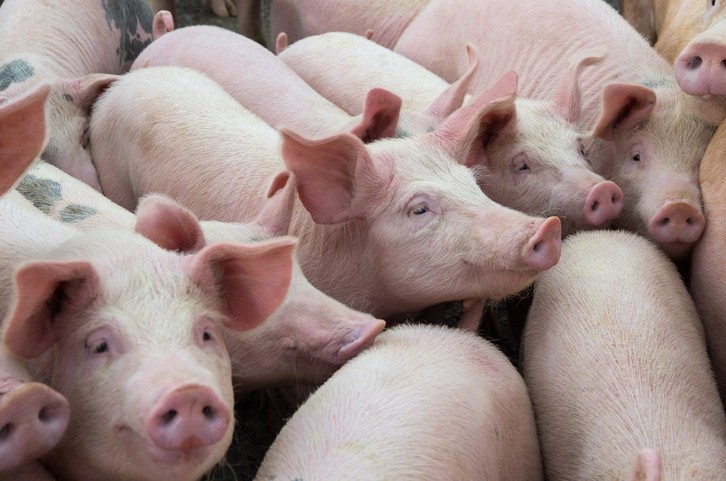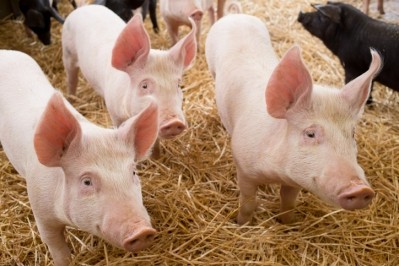Glutamic acid shown to improve the feed efficiency of weaned piglets

An international team of researchers from Canada and Brazil explored the use of supplemental nucleotides (NU) or glutamic acid (GA) in feed on the growth and intestinal development of weaned piglets.
The study was published in the journal, Livestock Science.
“This study aims to assess the effects of dietary supplementation with NU and GA on growth performance and intestinal replacement time of 13C in weaned piglets, using the isotope dilution technique,” the researchers said.
In an initial feeding trial, adding NU to the diet improved the gain to feed ratio (G:F) during the last part of the trial (days 28 to 35) and supplemental GA improved the G:F throughout the experiment period, the researchers said.
During the second feeding trial, researchers found that adding NU to diets, and combining NU and GA improved the time needed to replace 13C in duodenum mucosa when compared to pigs on the control diet.
“Dietary supplementation with NU and/or GA improves growth performance in weaned piglets, acting through different metabolic pathways,” the researchers said. “The greater incorporation of 13C suggests that dietary NU supplementation stimulated the deposition of nutrients in the duodenum tissue.”
Why add nucleotides, glutamic acid to piglet diets?
In commercial production weaning times have been shortened to allow for accelerated farm production, the researchers said. The shift means that weaned pigs have to adapt quickly to changes in social, dietary and physical environments.
The inability to respond to changes can lead to intestinal damage following weaning and reduce both growth performance and feed efficiency while compromising intestinal integrity, they said. Following the interest in reducing the levels of antibiotics used in swine production, there has been an increasing interest in nutritional additives that could be used to address the challenges.
Supplemental glutamic acid (GA) and nucleotides (NU) are among the nutritional compounds considered, they added.
Large amounts of NU are used by the gastrointestinal tract to support cell replication and tissue regeneration, the researchers said. The metabolic process to synthesize NE endogenously, however, requires a substantial amount of energy.
“However, the metabolization of dietary NU is more energetically efficient to support post-weaning intestinal renewal and has positive effects on growth,” they said.
GA provides glutamate during digestion, which has a role in protein synthesis, “enterocyte energy production,” and the production of other amino acids, they said.
“Considering that dietary NU and GA positively impact energy metabolism and intestinal renewal through several pathways aforementioned, the interaction between them may potentially have additive effects especially under the particular conditions of post-weaning,” the researchers said. The combination of both may improve cell recovery during stress periods, they added.
Additionally, little is known about the role that supplemental NU could play in addressing piglet gut health following weaning, they said.
“To understand the effects of NU and GA for recovering the intestinal cells of pigs, the dietary 13C replacement time in this tissue can be assessed using the isotope dilution technique,” they said. “This technique estimates the replacement time of a chemical element in different animal tissues, which can be involved with the tissue nutrients deposition and/or tissue development.”
Feeding trials
The research group conducted two feeding trials to assess the effects of providing dietary NU and GA on both growth performance and gut development, the researchers said.
In the initial trial, 84 piglets were tracked for growth performance during three phrases of growth day 0-15, 16-27 and 28-35, they said.
The four diets fed included NU and GA at two different levels – NU at 0 or 0.1% and GA at 0 or 1%, they said. The feeds included rice, soybean meal and dry whey.
Pigs were weighed weekly, and average daily feed intake (ADFI), average daily gain and the G:F were determined for all production phases, they said.
In the second trial, 87 piglets were tracked for gut development using the intestinal replacement time of 13C based on the provision of 13C in the maternal diet and when post-weaning diets were used, the researchers said. Piglet diets were generated with rice, rather than the corn used in sow diets, to assess the 13C replacement in the duodenum and jejunum following weaning.
A sample of piglets was used to establish the initial 13C ratio in the duodenum and jejunum at weaning, they said. Additional piglets were harvested on days 3, 6, 9, 14, 21, 34 and 49 and parts of the duodenum and jejunum were gathered to determine the incorporation of 13C in the tissue of the small intestine by piglets on the supplemented diets or control diet.
Results
In the first feeding trial, no effect was found for NU use or for NU and GA when considering the whole production period, the researchers said. However, the G:F was increased for pigs on the diet with supplemental GA and they tended to be slightly heavier.
“From day 0 to 15 post-weaning an interaction effect was observed in which animals supplemented with NU × GA presented the lowest ADFI,” they said. “The G:F was higher (p = 0.04) for GA supplemented than for GA non-supplemented animals. Lower ADG was observed in NU supplemented than NU non-supplemented animals.”
“From day 28 to35 post-weaning both NU and GA supplemented animals had higher G:F than non-supplemented animals,” they added.
In the second feeding trial, adding NU or both GA and NU to the diets improved the replacement of 13C in duodenum mucosa compared to the control, the researchers said. However, replacement in the jejunum was similar to the control.
“The use of dietary NU and GA during the post-weaning period improves performance but only NU accelerates the replacement time of 13C on duodenal mucosa during the post-weaning period in pigs,” they said.
Source: Livestock Science
DOI: doi.org/10.1016/j.livsci.2019.07.008
Title: Growth performance and intestinal replacement time of 13C in newly weaned piglets supplemented with nucleotides or glutamic acid
Authors: L. Santos, G. Miassi, M. Tse, L. Gomes, P. Berto, J. Denadai, F. Caldara, D. Dalto, D. Berto















